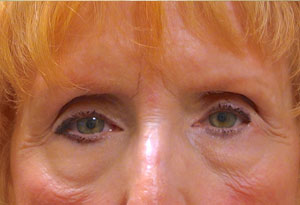Ptosis Repair Surgery
Southern California's Premier Eyelid Surgery Center
Droopy eyelids may be a sign of age, but they can also occur due to issues with the eyelid’s structures. Eyelid ptosis repair can reposition your eyelid to a natural, bright position. Dr. Jeffrey Joseph is proud to offer this procedure to patients in Southern California and from across the country.
Financing
What Is Eyelid Ptosis?
Eyelid ptosis (or blepharoptosis) refers to an upper eyelid drooping below its normal position. Ptosis can affect one or both eyes. Ptosis can block your vision and is often considered a medical issue if the edge of the eyelid is covering any part of the pupil (black circle at the center of the eye). The condition can range in severity from mild drooping to severe drooping with vision impairment. This low-lying position of the eyelid edge can make the eyes look tired, heavy, and aged.
Although ptosis does not always affect visual acuity (except in children), it can block the superior portion of the visual field. Other symptoms include fatigue of the forehead and eyebrows, which is most notable when reading. Some patients must maintain a chin-up position to be able to perform their normal activities.




What Causes Ptosis?
Ptosis can have one of several causes. The method used to repair ptosis can depend on the cause and its severity. Ptosis generally occurs as a result of stretching of the eyelid muscles. This is usually due to age but can also result from previous eyelid surgery or simply the long-term use of contact lenses. That being the case, children can also have ptosis if they are born with weak eyelid muscles.
Aponeurotic Ptosis
The most common cause is known as aponeurotic ptosis. This is a result of the muscle that normally elevates the eyelid slipping or becoming detached from its normal attachment to the structural portion of the eyelid, known as the tarsus. This can be a result of:
- Aging (involutional ptosis)
- Contact lens use
- Previous surgery
- Trauma
Congenital Ptosis
Another type of ptosis is known as congenital ptosis. Congenital ptosis is typically present since birth. It results from poor development of the levator muscle of the upper eyelid. Other causes include muscular and neurogenic problems.
Ptosis Treatments & Procedures
Ptosis treatment is based on the severity of the droopiness and function of the levator muscle, which elevates the eyelid. Common ptosis (aponeurotic ptosis) can be treated in several ways. One way involves going from the inside surface of the eyelid (internal approach conjunctival/Mueller muscle resection). Another involves going from the outside surface of the eyelid (external approach levator aponeurosis advancement).
- Conjunctival/Mueller Muscle Resection: This is performed on the internal surface of the upper eyelid and avoids a skin incision, so there is no scar on the eyelid to worry about. This is a good option for some patients, depending on what Dr. Joseph learns during the testing period performed as part of the consultation.
- Levator Advancement: This is a longer procedure in which the levator muscle is advanced to a stronger position in the eyelid, giving it a better grip to elevate the eyelid.
- Frontalis Sling: Congenital ptosis and certain types of paralytic or myogenic ptosis typically have very poor muscle function. These types of ptosis are usually treated with a frontalis sling procedure in which the eyelid is directly attached to the eyebrow.
What Is a Ptosis Repair Procedure Like?
- Anesthesia: In adults, surgery is usually performed while the patient is awake. Repair may be performed with either local anesthesia, local anesthesia with sedation, or general anesthesia, depending on the approach. Dr. Joseph will discuss these options and details during your consultation.
- Duration:● average surgery usually requires between 30 to 60 minutes. However, this time will vary depending on the specific goals that you and Dr. Joseph set forth. Every surgery is unique, and to achieve the absolute best result, no surgery is ever rushed.
What Is the Recovery Like?
Recovery varies by individual. The eyes are usually swollen and bruised for 1 to 2 weeks. There can be some pain after surgery, but it is usually well controlled with ice compresses and over-the-counter medications.
Recovery occurs gradually, and not all patients have the same rate of healing. At each stage, we recommend patients carefully follow their surgeon’s aftercare instructions.
While you can return to most activities within a few weeks, continue to be attentive to your eyelids. Your eyelid muscles are always vulnerable to injury and damage. But they need particular care following surgery.
How Long Do the Results Last?
Your eyelid can take some time to settle into its final position. Most patients will see final results within 2 to 3 months. This happens because all residual swelling must fade before the tissues finally settle.
A well-performed ptosis repair procedure should produce a lifetime of benefits. However, the eyelid muscles will remain vulnerable to damage. Avoid rubbing your eyelids, which can gradually wear down the muscle. Additionally, stay mindful of contact sports or other high-risk activities.
The eyelid may change position over time. However, this happens naturally with age. It may not represent a ptosis issue. Instead, the eyelid skin tends to stretch with time. For some patients, this may look like a droopy eyelid.
Schedule a Consultation
Contact Dr. Joseph’s Southern California office to schedule your consultation for ptosis repair. Restore your vision and enhance your comfort with a single procedure. Call our office to learn more about this procedure and set up your visit.
We also invite out-of-town patients to set up an in-person or virtual consultation. Our designated patient care coordinator works closely with patients from across the nation (and the globe) to promote a safe, hassle-free experience both before and after your ptosis repair procedure.







